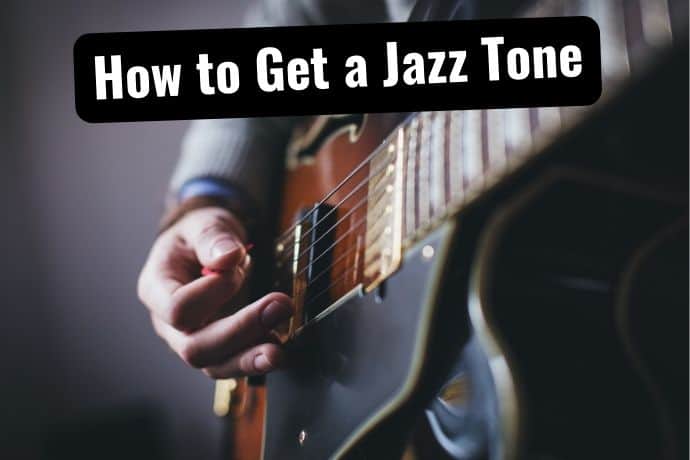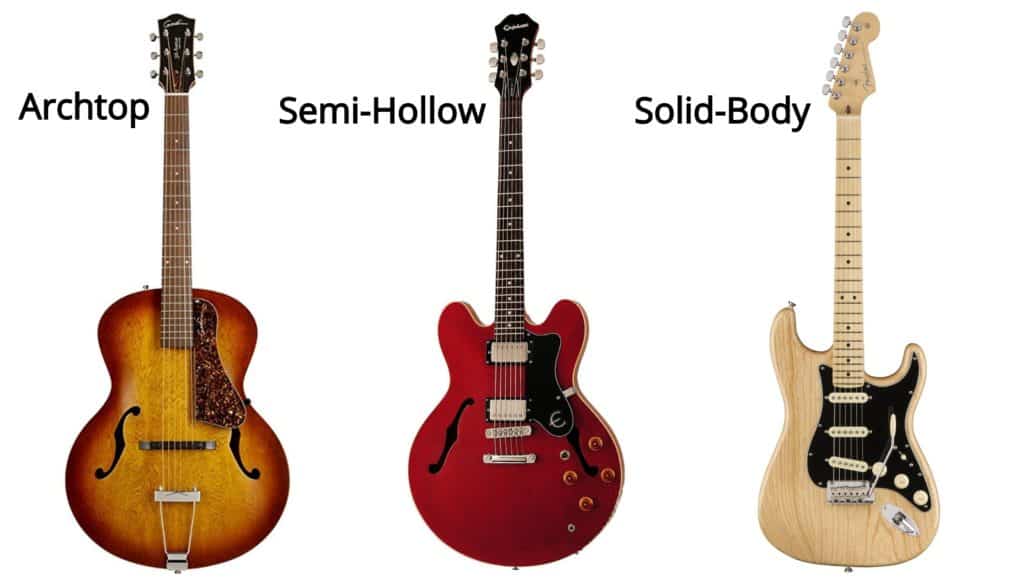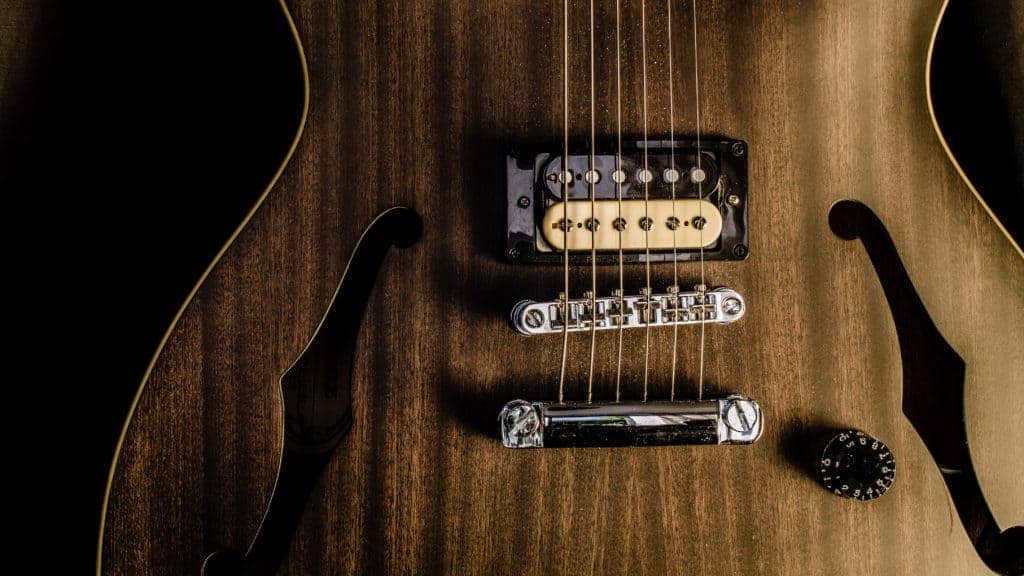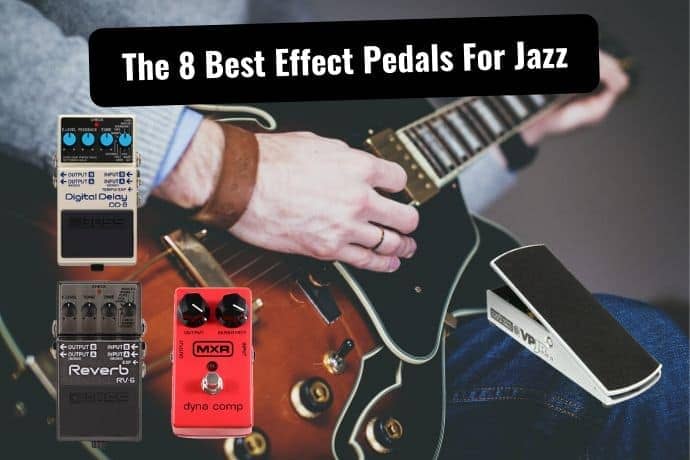
Jazz is an illusive, ear-catching, and challenging style of guitar. Although the majority of your sound comes from your playing. Some essential knowledge is required to tweak and sculpt a smooth, mellow tone perfect for that jazz flavor.
This Post Will Teach You…
Whether you’re a beginner, intermediate or an advanced player? This article is the essential guitar players guide on how to get a great jazz tone.
This post will discuss guitars, amps, tips, and essentials! Transforming your average clean tone to a dark, mellow, and jazzy sound (combined with your good playing of course!)
So without further ado, let’s start with factor number 1…
#1 – Your Playing is the Foundation
When trying to sculpt the jazziest sounding guitar tone, the good news is you don’t need any technical, specific, or overly expensive gear (Hooray for that!)
Mainly because the core sound of jazz is generalized as a playing style rather than a specific tone. The hard work is actually mastering how to play this unique and challenging style of guitar!
I don’t want to sound cliché but it has to be repeated…
Tone is “all in the fingers.”
Hence why this point is first on this list. Meaning… fluency, timing, phrasing, technique, touch, etc is the foundation of any great jazz guitar sound.
You essentially voice your musicality through your gear. How you decide to EQ your amp, guitar, use effects, and tweak the rest of your rig is roughly the remaining 30% of your sound.
The Main Point
An excellent Jazz player will make any budget guitar and gear sound great. Whereas, an average and sloppy jazz player can make an expensive guitar and gear sound less than impressive.
Therefore, to keep improving your ‘jazz sound’ you must progressively keep improving as a guitar player because tone is 100% in the fingers (sorry to mention it again.)
How to Improve your Jazz Playing
To progressively improve your playing is an enjoyable lifelong process. Me explaining how to improve your jazz playing, however, does require a huge separate article altogether.
But to save time, these quick bulletproof tips will keep you improving your skills as a guitarist if you implement them frequently.
Top Tips for Advancing Your Jazz Playing
- Improvise over backing tracks
- Learn your scales (Major, Minor, Jazz Scales)
- Jam with other jazz guitar players
- Have a practice plan
- Work on difficult techniques that hinders your playing
- Work on your weaknesses
- Learn your theory
- Try to play what you hear instead of using tabs
- Listen to your Jazz guitar heroes and study their playing
- Play as often as you can
- Practice and then practice some more
Here is a great in-depth article I recommended ‘How to improve your jazz playing’ you should check out!
2# – The Warm Mellow Clean Tone
The smooth sound of Jazz guitar is rewound for sounding clean, warm and mellow.
This means no gain or distortion in the signal chain, just a dry and crystal clear transparent sound coming through the amp.
Now a “great jazz tone” is a little subjective depending on who you ask. Some Jazz players may prefer a super ‘warm’ and ‘muddy’ clean tone, while others may like a brighter and more ‘piercing’ clean sound.
So who is right?
The answer is nobody! Tone is quite a personal thing, it all depends on your tastes and what sounds best to your ears.
It also depends on your guitar, amp, EQ settings, strings, etc which will also play a huge part in your sound.
How to Tweak a Jazz Tone
- Experiment with your presets and gear settings
- listen to your favorite jazz players and emulate their sound
- Ask what tones sound best suits to your playing style
- Ask if your current tone is muddy or bright?
- Record yourself and choose which sound you prefer
3# – Understanding Guitar Choice
The good news is that you can play jazz on any type of guitar. Acoustic, hollow-body, semi-hollow and solid-body. Historically all of them have played by many famous jazz artists over the years.

Your choice of guitar ultimately depends on the type of sounds you want to sculpt, and the guitar that plays and sounds the best to your ears.
Let’s take a look at some of these…
Hollow-Body/Archtop Guitars
Hollow-body also refereed to as the ‘archtop’ guitar, are the iconic and classic instrument when any player pictures a jazz guitar.
Wes Montgomery, Pat Metheny, Johnny Smith, etc they all played one, bringing the classic sound of jazz through its peak years.
The Archtop Tone
What sets hollow-body guitars apart tonally is they sound very warm, bassy, dry and hollow.
Because of the design, the large hollow body naturally enhances the low-end frequencies offering a warm, thick and bassy tone.
Some seasoned jazz players even claim that archtops guitars allow for the ‘authentic’ playing and jazz tonal experience.
When it comes to variations, archtops can come in two distinct flavors…fully acoustic or semi-acoustic.
The semi-acoustic version contains a neck pickup, so they can be connected to an amp for sound projection. (They sound better through an amp in my opinion.)
The acoustic version includes the distinct ‘F-holes’ for acoustic sound projection.
Downsides to Hollow-Body Guitars
The downside to a hollow body is explained like a ‘double-edged sword.’ Basically, what gives them their sound also affects their playability…quite badly!
Because of their large size, they’re not the easiest to play and are quite cumbersome.
They also come stock with thick and bulky necks meaning they are not the best choice for a beginner or players with smaller fingers who like to play lead lines fluidly around the neck.
Other problems are feedback issues when played at high volumes due to its hollow design.
Hollow bodies may not be as popular as they used to be, but when it comes to a classic jazz guitar for a smooth and traditional sound. The archtop is a great choice for the hardcore and traditional jazz players out there.
Pros
- Authentic jazz tone
- Naturally warm and mellow
- Light
- Affordable
Cons
- More difficult to play compared to other options
- Bulky necks
- limited amount of sustain
- Not as much customization for tone with lack of tone knobs
- Not a versatile in other sounds or styles (rock for example)
- Prone to ‘feedback’
- Usually a ‘single-cutaway’ so high fret access is slightly impaired
Semi-Hollow Guitars
The semi-hollow is seen as the ‘in-between’ guitar being smaller than an archtop but bigger than a solid-body while still containing some acoustic projection via its F-holes.
The semi-hollow is a very popular jazz guitar but is adopted by players in a host of other genres ranging from rock, blues, and indie.
Another great selling point is it’s versatility from dirty rock rhythm, dialed all the way back to warm, lush and mellow clean jazz tones.
The reason they are called a semi-hollow body is that they include a center block within the body which functions to tame that annoying and pesky feedback.
This addition means they sound less hollow, bassy and full. However, the guitar is more versatile, as they can manage feedback opening the door for other tones in other genres such as rock and blues.
The Semi-Hollow Tone
The reason they sound so good for jazz is because they are super mellow and rich in mid-range frequencies.
Semi-hollows also promote more sustain meaning notes can be held for longer which is good for solos. They also have enough high-end frequencies to cut through a band mix and be heard better within a live setting.
They are also easier to play than a hollow body as the body and neck are leaner easier for fretting notes and chords.
They also have a ‘double cutaway’ design to a hollow body single cut design. This means they have better high fret access for fretting high register notes for soloing.
I have to admit, for a beginner wanting to learn jazz, I would always recommend a semi-hollow body every time due to their playability, versatility and great sound.
But as mentioned the right guitar is the one that suits your personal preferences and floats your boat as your ideal guitar for playing jazz.
Pros
- Cut through a band mix
- Mellow, and hollow tone
- Warm tones
- Great playability
- More sustain
- Versatile in sounds
Cons
- Still feedback problems but not as significant as hollow-body
- Not as much acoustic sound projection
Solid-Body Guitars
As jazz-rock fusion emerged in the early 1970s, players began opting towards the more piercing and woodier sound of the solid-body guitar.
Fast forward to the modern era of jazz, there’s a continuing upward trend with solid-body guitars being the popular choice for modern players.
Solid-Body Guitar Tone For Jazz
Solid-body guitars are rich in ‘high-end frequencies’ due to their full-body construction, offering tons of attack and presence (especially with single coils) when the tone and volume knob is maxed out.
Solid-body guitars are naturally less mellow and clean tones sound more ‘woody’ compared to a warmer sounding archtop and semi-hollow guitar.
A solid body guitars EQ will often need adjusting to removing some ‘top-end’ from the signal for sculpting a warmer and jazzier tone.
This would be to play around with the guitar’s tone/ volume knobs and amp settings. This is to remove some high-end and adjust the tone accordingly to your ears with the gear you have.
The trick is getting enough warmness without burying the sound and notes for a clean and mellow tone.
Mike Stern, Ted Greene, and John Schofield are some examples of some famous jazz guitarists using solid-body guitars . All these musicians are known to play the iconic Fender Telecaster, creating some of the best jazz tones ever heard.
It goes without saying but solid-body guitars should always have the neck pickup engaged (especially with single coils) for a thicker, fuller and warmer sound.
Humbuckers are always the best choice for resembling the tone similar to a hollow body guitar as they are thick, warm and naturally bassy.
Another benefit to solid-body guitars is that they are easier to play and contain tons of sustain due to the heavy chunk of wood on board compared to archtop guitars.
They are also feedback-free and are the most versatile when it comes to tones for playing many other genres of music.
Pros
- Versatile
- Easier to play
- Thinner necks
- Comfortable
- No feedback
Cons
- Not the most mellow sounding guitars
- Need some EQ tweaking to get them sounding jazzy
4# – Knowing Your Pickups

Traditionally, humbuckers are the preferred pickup for replicating any style and sub-genre of jazz. Nearly all archtop guitars and semi-hollows (jazz guitars) come with humbuckers installed for a very good reason…
When combined with a clean tone, humbuckers have a naturally warm, thick, and beefy sound being the identifiable guitar tone that all jazz players traditionally desire.
Depending on the guitar they are fitted with ie hollow, semi-hollow or solid-body.
You have the option to control the darkness, bass response, and presence of the core sound either with the guitar or amplifiers EQ. This will be to suit the type of tone you want out of your gear.
Neck or Bridge Pickup?
In terms of pickup choice, the neck pickup will be the usual pickup selected if your guitar has a choice of neck and bridge pickup. As the neck pickup produces the warmest and fattest tone compared to the bridge pickup.
In my experience, playing through an amp with a clean tone is what really can show the difference between a good guitar and a bad guitar. It’s one way how I judge the quality of the sound.
Things such as response, note transparency, nuances which will always come through on a clean setting compared to distortion which can color the tone.
What About Single Coils and P90s?
Although I have just been singing the praises of humbuckers, other pickups such as single-coils and P90s can definitely work for adopting a jazz tone.
Many famous Jazz artists continue to use Telecasters and Stratocasters adopting single-coil pickups creating some impressive sounds.
Just keep in mind, when using a guitar without humbuckers, you will have to roll a considerable amount of top-end from the signal by rolling off the guitar’s tone knob and keeping treble and presence to a minimum on the amps settings.
This is to darken the naturally bright tone from single-coils and P90s essentially mellowing the tone and making it sound darker.
5# – The Jazz Amplifier
The amp is an important part of your rig and a large slice of your tone. Having an amplifier that captures your fluent jazz playing while amplifying it clearly, with good dynamics and harmonics will project a great jazz sound.
Why ‘Headroom’ is Important
Now the sonic quality of your clean channel is going to be the ‘bread and butter’ setting on your amp.
Ideally, a good amplifier for jazz will have plenty of ‘headroom’ so it will not distort and break-up when you begin to turn the volume up past a certain level.
This is so the tone will stay clean, transparent, and be absent of any gain or break-up. Remember we want a clean and mellow jazz tone, not an AC/DC rock tone!
Other aspects that are important are responsiveness to EQ, speaker size, speaker clarity, reverb, etc.
Tube Amplifiers for Jazz
Tube amps are known for their true, crystal clear, and signature tube tone whether it’s distortion or for an ambient clean tone.
Mainly because they utilize power tubes to amplify their signal producing a warm, responsive and the signature tone of tube-powered amplification.
Historically, popular tube amplifiers that jazz players tend to gravitate towards are Fender amps for their classic and signature tube sound.
For decades, the ultimate tube amplifier for jazz artists belonged to the undisputed Fender Twin Reverb, way before amps emerged with solid-state technology. It was powerful, big, heavy, and expensive but it created some of the most legendary clean tones with the most ambient sounding analog reverb.
In the modern era, jazz full tube-powered valve amps have had their heyday not being as popular as they used to due to the evolution of solid-state and digital modeling technology.
However, you cannot beat the true and classic sound of a tube amplifier for a classic and smooth jazz clean clean tone.
Some small and affordable tube amps I recommend for jazz players are…
- Fender Blues Junior
- Fender Bassman
- Fender Princeton
- Fender HotRod Deluxe
- Fender Ultralight Jazzmaster
Solid-State/Digital Amps For Jazz
In the modern era, gigging jazz players now gravitate towards the compact and portable amps which use a combination of tube and transistor technology to get their sound.
This makes them smaller, portable, cheaper without and the added benefits of more features such as effects, AUX and speaker inputs.
Solid State Tone
When it comes to tone, these amplifiers notably sound slightly warmer and less transparent as tube amps due to their digital nature.
However, jazz players have known to prefer the warmer and transistor clean sound from solid-states due to its fuller and thicker sound.
Even so, there have been countless solid-state and digital amps marketed over the years from brands primarily towards the jazz players.
These amps are usually compact and emphasize the quality of the clean tones creating these amps to produce a smooth, transparent and great tone form the clean channel.
Some great choices for solid-state amps are…
- Roland JC-120
- Roland JC-22
- Roland Cube
- Boss Katana
- DV Mark amps
- Polytone amps
- Henriksen amps
Solid-state amps contain less available headroom than valve amps and can begin to distort slightly when passed a certain threshold of volume.
Meaning with a clean tone that pushed to hard with volume means a solid-state can suddenly become harsh and overly compressed.
When using a solid-state for clean tones, it is essential that it is of a high enough wattage meaning that it will have all the available headroom for when the volume is turned up for gigs and rehearsals.
I have an epic post you should read called the “The Best Solid-State amps For Jazz.” This review post will give you some awesome affordable solid-state recommendations.
6# – Choosing the Correct Strings for Jazz
When guitarists attempt to sculpt a jazz tone which is smooth and silky, players focus considerable energy on guitar choice, amp choice, and EQ settings.
Yet, a large majority of players overlook a small ingredient that can vastly improve the thickness, output, and dynamics of their tone when voiced on a clean channel.
The vital ingredient is simply choice of strings and the gauge you use!
Choose Heavy Strings
Simply, heavy gauged strings are the better option for playing jazz as they produce a warm, thick, and bassy tone compared to a lighter gauged set.
Typically, anything from 0.10-0.12 is a good range to shoot for but a set of 0.12 really let your guitar sing to its full potential in terms of warmness, dynamics, and output.
Many famous and professional jazz players traditionally use 0.12 as their staple gauge for a classic, warm and full sound.
Especially if you are using a solid-body guitar then don’t be afraid to put 12s on a Fender Stratocaster or Telecaster it will sound thicker and be a joy to play.
Keep In Mind With Heavy Strings
I must admit, heavier strings are harder for string bends which is one of the main negatives of thicker strings.
However, the jazz style and technique is not exactly known for its string bends compared to rock and blues for example. Meaning, light and flexible strings are non-essential for jazz playing purists out there.
On the other hand, if you happen to play other styles and genres, the best advice would be to experiment with different gauges to find the set that suits you best in terms of flexibility and tone.
Flatwound vs Roundwound Strings
When it comes to string choice, ‘flatwound strings’ are the traditional option for jazz players for a warmer and mellow tone.
The reason is they naturally produce a dark and dull sound compared round-wound strings which are the usual choice for solid-body guitars.
Especially if you play a solid-body guitar, flatwound strings are the best option as they will remove brightness from your tone allowing it to sound less piercing and jazzier.
So if you have never tried flatwound strings give them a try, they will certainly assist adopting a duller and mellow guitar tone. Some recommendations are…
D’addario ECG24
Jazz Swing Flatwounds
Jazz Swing Bebop flatwounds
Optima Jazz Swing
7# – Guitar Effects for Jazz
When it comes to external effects for the typical jazz guitar player. Typically, there is usually no large and complicated pedalboard compared to say the rock and metal guitarist for example.
Jazz artists take a simplistic approach to tone with the simple notion that ‘less is more.’ Also, when you have a quality guitar and amplifier combination there is no need to complicate a good core sound further.
Check Out My Guide to Jazz Effects Pedals Below
I have a bigger and more comprehensive post on this subject you must view here…
“The 8 Best Effects Pedals for Jazz Players” (link opens in new tab)
This post outlines everything about the best effect pedals and why all jazz players must have them.
Reverb
Reverb is an essential pedal for adding ambiance and space, heightening the emotion and acoustics of your sound.
A good classic spring reverb either from the amp or an external pedal adds a nice texture and soundscape to your tone, especially with slower jazz ballads.
Some players either like a hint of reverb or a very wet sound giving the illusion of playing in within large room or hall. Some reverb pedals are also very affordable and vary in features and sounds.
Compressor Pedal
A hint of compression can do wonders for the dynamics of any type of clean tone.
It essentially compresses the highs and low frequencies closer together allowing the guitar tone to sound even in terms of volume and attack. It also increases the volume of the lower frequencies to cut through a mix and lift the tones overall volume.
A compressor may not be as important with a guitar with humbuckers installed, as humbuckers naturally compress the guitars sound.
However, single coils and P90s are naturally quieter than humbuckers which is a situation where a hint of compression can be useful.
A compressor pedal can also be utilized as a ‘boost’ control, for a subtle volume and dynamic boost to stand out from the rest of the band when playing a solo of a song in a live setting.
As you can see, there are many useful situations for a compressor pedal so adding it to your arsenal is a good decision.
Octave Pedal
An octave pedal for jazz? That’s right! Some jazz guitarists have been known to utilize an octave pedal for creating the sound of a bassline…without requiring a bass player.
The pedal can de-tune the low E string down an octave for the tonal illusion of a low and deep sounding bass.
Combined with a looper pedal, you can create basslines add rhythm and then play lead phrases over the recorded layers. Allowing you to get creative and play in a one-man jazz band.
8# – Pick Choice for Playing Jazz
I must admit, plectrum choice is not usually the priority piece of gear players think of for getting a smooth jazz tone.
With that said, the right plectrum choice is optimal for increasing speed and equipping you with the correct pick for playing fast lead jazz phrases.
Choose a Thick Plectrum
Typically jazz players opt for thick plectrums for a few reasons. A thick and rigid pick is required for plucking heavy gauged strings (0-10, 0-11, 012) the usual string choice jazz players option for.
A heavy gauged plectrum is also better for lead orientated playing, the usual style of jazz guitar whereas thinner picks are better for rhythm and strumming based playing.
Secondly, a heavy gauged plectrum produces more attack and presence producing better tones than a flexible plectrum.
So what gauge pick do I recommended…
A minimum thickness of 1mm would be a good starting point but it entirely depends on your playing style and what feels more comfortable to you.
I always recommend experimenting with different plectrums to find the one that suits your playing and preferences the best.
Pick Recommendations
The best type of picks for jazz are the ones that are thick and designed for speed if you happen to be a technical player.
These picks are smaller, include sharper points and have prominent bevels better suited for fast lead runs.
If you want to see my pick recommendations, you have to view my post “ best picks for speed and fast playing” These picks are some of the most popular choices for lead orientated playing.
Thanks For Reading!

